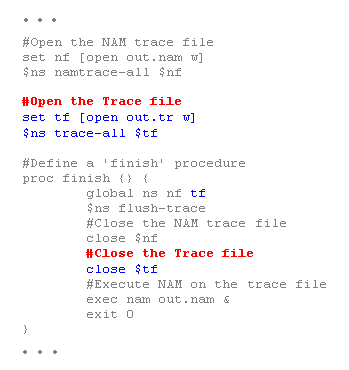Trace Analysis Example
- This section shows a trace analysis example. Example 4 is the same OTcl script as the one in the "Simple Simulation Example" section with a few lines added to open a trace file and write traces to it. For the network topology it generates and the simulation scenario, refer to Figure 4 in the "Simple Simulation Example" section. To run this script download "ns-simple-trace.tcl" and type "ns ns-simple-trace.tcl" at your shell prompt.

Example 4. Trace Enabled Simple NS Simulation Script (modified from Example 3)

Figure 13. Trace Format Example
Having simulation trace data at hand, all one has to do is to transform a subset of the data of interest into a comprehensible information and analyze it. Down below is a small data transformation example. This example uses a command written in perl called "column" that selects columns of given input. To make the example work on your machine, you should download "column" and make it executable (i.e. "chmod 755 column"). Following is a tunneled shell command combined with awk, which calculates CBR traffic jitter at receiver node (n3) using data in "out.tr", and stores the resulting data in "jitter.txt".
| cat out.tr | grep " 2 3 cbr " | grep ^r | column 1 10 | awk '{dif = $2 - old2; if(dif==0) dif = 1; if(dif > 0) {printf("%d\t%f\n", $2, ($1 - old1) / dif); old1 = $1; old2 = $2}}' > jitter.txt |

Figure 14. CBR Jitter at The Receiving Node (n3)
No comments:
Post a Comment